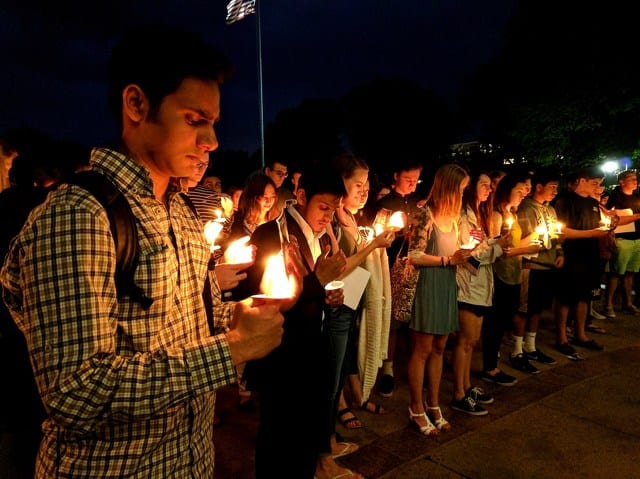Last night, campus and community members gathered for a candlelight vigil to honor Penn State student Nick Flacco, shot and killed in Philadelphia over the weekend.
Two weeks ago, campus and community members gathered for a candlelight vigil to honor Osaze Osagie, shot and killed by a State College cop.
A few days earlier, campus and community members gathered for a candlelight vigil to honor the 50 people shot and killed at two mosques in New Zealand.
In January, campus and community members gathered for a candlelight vigil to honor Steve Beachy and Dean Beachy, shot and killed in a State College bar, and George McCormick, shot and killed by the same gunman in a nearby house.
In October, campus and community members gathered for a candlelight vigil to honor the 11 people shot and killed in a Pittsburgh synagogue.
I’m sick of candlelight vigils.
OK, I’m not really sick of the vigils themselves. I’m sick of the need for vigils, which is to say, I’m sick of gun violence and I’m sick of a response to gun violence that never goes beyond candlelight vigils.
It’s taken me a few days to sort out my reactions. Last week, I confess, I was exasperated with the vigils themselves. What good do they do, I asked myself. And shouldn’t we wait for at least a few facts to come out before we plug the tragedy of Osagie’s death into a readymade white-cop-on-black-man narrative?
I read similar complaints on social media. Yes, the complainants said, let us mourn for Osagie and feel for his family, but let us not condemn the cop as a trigger-happy racist until we know more – about him and about the degree of danger he faced, which might mainly be a matter of how close Osagie’s knife was to the policeman’s body.
A gun-toting friend of mine – maybe my only gun-toting friend – told me if a guy’s coming at him with a knife, he’s shooting to kill, period.
A complete naïf about such things, I wondered why trained cops couldn’t disarm a man with a knife, why he couldn’t have been tased rather than shot, why he couldn’t have been disabled by gunfire rather than shot dead.
On Sunday, an essay in The New York Times on “virtue signaling” caught my eye. The writers, psychologists Jillian Jordan and David Rand, define the term as “feigned righteousness intended to make the speaker appear superior by condemning others.”
Exactly, I thought. Showing up at the vigil for Osaze Osagie seemed like a way for white liberals like me to exhibit their piety on matters of race.
This was unfair and uncharitable.
I read on. Jordan and Rand weren’t calling out the phonies, as I first thought. Pitting conspicuous displays of outrage or piety against genuine moral indignation is a false dichotomy, they wrote. From a set of experiments I won’t detail here, they concluded that “people have a subconscious desire to signal their virtue” – and that one can both be a good person and wish to be perceived as a good person.
Indeed, the whole idea of “setting an example” rests on the idea that virtuous conduct may inspire virtue in others.
The reliably clear-thinking Rebecca Solnit makes a similar argument in an essay titled “Preaching to the Choir.” The idiom suggests that we are wasting our time when we show up at vigils or rallies or protest marches because our fellow participants already agree with us. What we need to be doing is trying to change the minds of those who disagree with us.
Solnit, though, reminds us of the wonders that congregation and connection can do for our morale. It’s “how we find out who our friends are,” she writes. The best conversations of her youth, she recalls, “reinforced that our perceptions and emotions were not baseless or illegitimate, that others were on our side and shared our experiences, that we had value and possibility. We were strengthening ourselves and our ties to one another.”
That sounds like a good description of what happens at candlelight vigils.
There was another reason to support the candlelight vigil in memory of Osaze Osagie, and this is the most important one. Whatever we learn from the investigation of his death, the fact that a white cop shot a black man here, locally, not in Ferguson or Baltimore or Cleveland or Charleston or Minneapolis, has been profoundly unnerving to blacks who live in State College.
I’ve heard and read that to be black in America is to not feel safe anywhere in the land. But to that general unease has been added a more palpable fear of what can happen in this town, what can happen to a black child being raised in this town.
It’s in solidarity with those who feel that fear that I must honor the candlelight vigils, even as I gnash my teeth at our inability to do more than huddle in the dark with lit candles in our hands.



